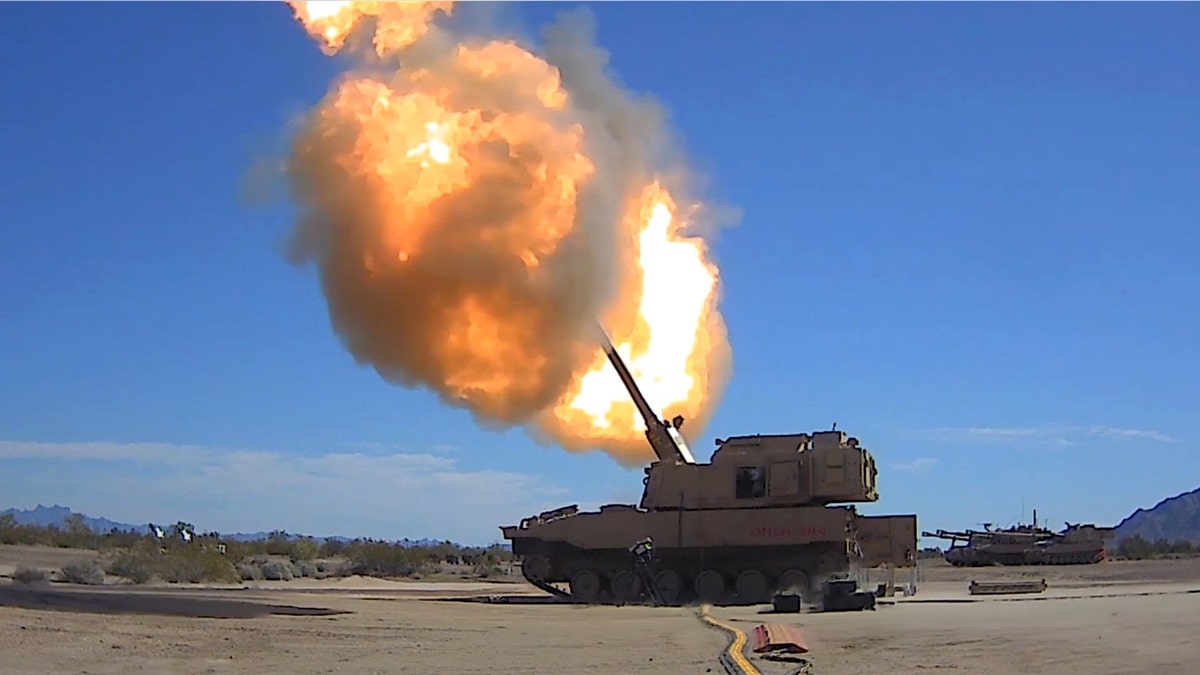
U.S. Army photo of the firing March 6 at Yuma Proving Grounds, Ariz. (U.S. Army)
When a precision-guided artillery projectile exploded an enemy target from 64km (39.8 miles) away in the Arizona desert during a recent live-fire exercise, the Army took a new step toward redefining land-attack tactics and paving the way toward a new warfare era in long-range fires.
In a March 2020 demonstration firing of the emerging Long Range Precision Fires program at Yuma Proving Grounds, Ariz., an Army Howitzer blasted an Excalibur 155m artillery round out to ranges twice that of what existing artillery weapons are now capable of. The new weapon in development, called Extended Range Cannon Artillery, not only preserves the GPS-guided precision attack options characteristic of present-day artillery, but also extends attack ranges from roughly 30km (18.6 miles) out to nearly 70km (43.5 miles). This, senior Army weapons developers explain, gives ground artillery commanders the ability to destroy previously unreachable air and ground targets.
“It enables commanders to attack their fight differently, provides them a number of weapon systems besides attack helicopters and unmanned aerial systems to go after targets that are further down the battlefield, deeper as we like to call it, in the battlefield," Gen. Joseph Martin, vice chief of staff of the Army, told reporters following the demo.
SOLDIERS USE AI TO FIRE PRECISION GRENADES, GUIDE DRONE ATTACKS
The new ERCA cannon, fired from a prototype self-propelled howitzer called the M1299, features a longer barrel and new, self-described “super-charged” propellant. The first operational systems are slated for delivery to the Army by 2023.
Martin explained that the service is now evaluating the operational concept of how this new weapon will be integrated and deployed, given that it naturally gives commanders new attack options that impact developing combat tactics and strategies.
Senior Army weapons developers explain that the ERCA system upgrades the breech and metallurgy of the tube, changes the hydraulics and uses a new ramjet projectile. The new weapon adds 1,000 pounds to the overall weight of the weapon and an additional six feet of cannon cube. "It also uses a redesigned cab, new breech design and new 'muzzle brake,'" a senior Army weapons developer told Warrior in a previous interview earlier in the program's development.
For example, a weapon with this reach could destroy enemy troop fortifications, bunkers, command and control centers or armored vehicle columns while keeping soldiers at safer stand-off ranges. This brings a particular added value in today’s threat environment, given that Russian and Chinese weapons and sensors are now reaching unprecedented ranges. The ERCA system could also destroy things like enemy air defenses ... from land … preventing air assets from needing to enter extremely high-risk airspace. Finally, as Martin described, an ability to hit enemy drones and helicopters from ground-fire artillery positions at long ranges enable advancing ground forces to protect their air space and thwart any approaching air attack.
ARMY SOLDIERS USE 'MACBOOK'-SIZED TABLET TO OPERATE MULTIPLE SMALL DRONES
The emerging system, which brings precision land-attack into a new era, is being engineered with a mind to integrating applications of AI as new technologies and algorithms become available, Martin explained. Of course, humans would be in the loop regarding decisions about lethal force, yet AI-enabled sensors, targeting systems and fire control could aggregate, organize and transmit crucial warfare information to commanders much faster and more efficiently than is currently possible. This, of course, opens up a new sphere of attack possibilities and massively expedites sensor to shooter timelines, increasing a commander’s ability to operate inside of or ahead of an enemy’s decision cycle. Martin explained that organizing data to identify the critical items of importance through AI will bring new advantages to soldier attack.
"We want the sensors to quickly get soldiers relevant data regarding what they are seeing. Our agile developmental process lends itself to this vision (AI), as it allows people to come in as innovators and make contributions,” Martin added.
This means that computer algorithms quickly analyze newly gathered sensor information and compare it against a vast database of known information to perform analytics, solve problems, sort out ambiguities and pinpoint moments of combat relevance from large amounts of otherwise difficult-to-organize sensor data.
ARMY TO TEST AND SHOOT WEAPONS AT NEW MOBILE PROTECTED FIREPOWER PROTOTYPES
Also, as a way of advancing cross-domain warfare coordination regarding targeting, AI and autonomy, Army LRPF developers are working closely with Next-Generation Combat Vehicle engineers, Brig. Gen. John R. Rafferty Jr., director, Long Range Precision Fires Cross Functional Team, Army Futures Command, told reporters.
“Brig. Gen Coffman (Director, Ground Combat Vehicles Cross Functional Team) and I are talking a lot and together taking a combined arms approach. In particular, I am learning more about the work he is doing in autonomy with ground vehicles,” Rafferty said.
As part of this broad effort to continue AI-enabled technology growth of the weapons system, Rafferty said the Army is now working intensely on developing an autoloader for the LRPF weapon able to fire as many as 10 rounds per minute.
CLICK HERE TO GET THE FOX NEWS APP
“The autoloader is under development at the armament center. It has matured and will be at Tech Level 6 [Army term for advanced development stage] by the end of this year. This will deliver a new volume of fire and work in any environment. It is in the lab,” Rafferty added.
